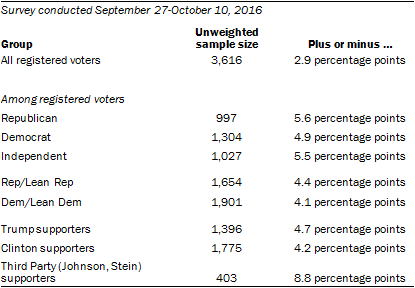Competitive congressional districts and states
Survey respondents were placed within their congressional districts by geocoding their self-reported addresses. The Cook Political Report identified a set of competitive congressional districts and states. As of October 13, 2016, the Cook Political Report classified 56 congressional districts into six categories: likely Democratic (CA-52, FL-10, MD-06, NY-25, VA-04), lean Democratic (CA-07, CA-24, FL-13, MN-02, MN-08, NV-04, NH-01, NY-03), Democratic toss up (AZ-01, FL-18, NE-02), Republican toss up (CA-25, CO-06, FL-07, FL-26, IL-10, IA-01, IA-03, ME-02, NV-03, NJ-05, NY-19, NY-22, PA-08, TX-23), lean Republican (CA-10, CA-21, CA-49, MI-01, MI-07, MN-03, NY-01, NY-23, NY-24, UT-04, VA-10, WI-08), and likely Republican (AK-AL, AZ-02, CO-03, FL-02, FL-27, IL-12, IN-02, IN-09, KS-03, MT-AL, NY-21, PA-06, PA-16, VA-05). Analyses that refer to “competitive districts” are referring to respondents who live within this set.
The Cook Political Report identifies 11 senate races as either lean Democratic (Illinois, Wisconsin), Toss Up (Nevada, Florida, Indiana, Missouri, New Hampshire, North Carolina, Pennsylvania), or lean Republican (Arizona, Ohio). Respondents living within any of these states were classified as being a part of a competitive senate race.
Survey conducted September 27-October 10, 2016
The American Trends Panel (ATP), created by the Pew Research Center, is a nationally representative panel of randomly selected U.S. adults recruited from landline and cell phone random digit dial surveys. Panelists participate via monthly self-administered Web surveys. Panelists who do not have internet access are provided with a tablet and wireless internet connection. The panel is being managed by Abt SRBI.
Data in this report are drawn from the panel wave conducted September 27-October 10, 2016 among 4,132 respondents. The margin of sampling error for the full sample of 4,132 respondents is plus or minus 2.8 percentage points.
Members of the American Trends Panel were recruited from two large, national landline and cellphone random digit dial (RDD) surveys conducted in English and Spanish. At the end of each survey, respondents were invited to join the panel. The first group of panelists was recruited from the 2014 Political Polarization and Typology Survey, conducted January 23 to March 16, 2014. Of the 10,013 adults interviewed, 9,809 were invited to take part in the panel and a total of 5,338 agreed to participate.1 The second group of panelists was recruited from the 2015 Survey on Government, conducted August 27 to October 4, 2015. Of the 6,004 adults interviewed, all were invited to join the panel, and 2,976 agreed to participate.2
The ATP data were weighted in a multi-step process that begins with a base weight incorporating the respondents’ original survey selection probability and the fact that in 2014 some panelists were subsampled for invitation to the panel. Next, an adjustment was made for the fact that the propensity to join the panel and remain an active panelist varied across different groups in the sample. The final step in the weighting uses an iterative technique that aligns the sample to population benchmarks on a number of dimensions. Gender, age, education, race, Hispanic origin and region parameters come from the U.S. Census Bureau’s 2014 American Community Survey. The county-level population density parameter (deciles) comes from the 2010 U.S. Decennial Census. The telephone service benchmark is comes from the July-December 2015 National Health Interview Survey and is projected to 2016. The volunteerism benchmark comes from the 2013 Current Population Survey Volunteer Supplement. The party affiliation benchmark is the average of the three most recent Pew Research Center general public telephone surveys. The Internet access benchmark comes from the 2015 Pew Survey on Government. Respondents who did not previously have internet access are treated as not having internet access for weighting purposes. The frequency of internet use benchmark is an estimate of daily internet use projected to 2016 from the 2013 Current Population Survey Computer and Internet Use Supplement. Sampling errors and statistical tests of significance take into account the effect of weighting. Interviews are conducted in both English and Spanish, but the Hispanic sample in the American Trends Panel is predominantly native born and English speaking.
The following table shows the unweighted sample sizes and the error attributable to sampling that would be expected at the 95% level of confidence for different groups in the survey:
Sample sizes and sampling errors for other subgroups are available upon request.
In addition to sampling error, one should bear in mind that question wording and practical difficulties in conducting surveys can introduce error or bias into the findings of opinion polls.
The September 2016 wave had a response rate of 80% (4,132 responses among 5,185 individuals in the panel). Taking account of the combined, weighted response rate for the recruitment surveys (10.0%) and attrition from panel members who were removed at their request or for inactivity, the cumulative response rate for the wave is 2.6%.3





